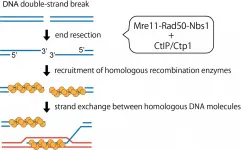Bioaccumulation of phased-out fire retardants is slowly declining in bald eagles
2021-03-10
(Press-News.org) Research published in Environmental Toxicology and Chemistry shows that the presence of polybrominated diphenyl ethers (PBDEs) in bald eagle populations is slowly declining. Bald eagles are apex predators that nest and, more importantly, feed along water bodies, making them excellent bioindicators of environmental contaminants that bioaccumulate up the aquatic food web. The findings are both good news for eagles and instructive for regulators tasked with managing surface water quality by setting protective levels for wildlife, as well as fish consumption advisories for humans.
Lead author Bill Route from the National Park Service Great Lakes Inventory and Monitoring Network, explained, "Bald eagles are similar to humans in that both are tertiary predators in aquatic systems. The patterns we observed in nestlings may be indicative of those in humans who consume fish from the same water bodies."
Introduced in the 1970s, PBDEs were designed as flame retardants and come in three primary formulations: penta-BDE, used primarily in furniture and cars; octa-BDE, used mainly in the electronics industry; and deca-BDE, used in a variety of appliances. Penta- and octa-BDE were phased out of use in the early 2000s and banned internationally in 2009 under the Stockholm Convention. Deca-BDEs were reduced and ultimately eliminated from manufacturing by 2013. Despite the regulations, PBDEs are still present in many products and continue to find their way into the environment. These chemical compounds are hydrophobic, which means they do not dissolve in water; instead, they stick to particles and settle at the bottom of rivers and lakes, where they are ingested by animals. Since they don't easily dissolve in water, they tend to sequester and accumulate in fatty tissue and subsequently get passed up the food chain.
Route and his co-authors assessed patterns and trends in PBDE concentrations in 492 bald eagle nestlings' blood samples from 241 territories across 12 study areas in Minnesota and Wisconsin. This work built upon previous studies in the same region, which enabled the authors to reveal trends. Perhaps unsurprisingly, the highest levels of PBDEs were found in urban areas, such as Minneapolis-St. Paul, and the lowest concentrations were in sparsely populated areas. However, overall, the research shows a sustained 3.8% annual rate of decline in the concentrations of five primary PBDEs in the samples collected across the region since PBDE production was reduced.
INFORMATION:
[Attachments] See images for this press release:

ELSE PRESS RELEASES FROM THIS DATE:
2021-03-10
Scientists at Tokyo Institute of Technology (Tokyo Tech) have uncovered mechanisms underlying the activation of the MRN complex-- the cell's DNA scissors. Using purified yeast proteins, they demonstrated that phosphorylation of Ctp1, a homolog of a tumor-suppressor protein, plays a key role in activating MRN complex's DNA clipping activity. Intriguingly, a short segment of yeast Ctp1 or its human counterpart could stimulate endonuclease activity of their respective MRN complexes, suggesting its conserved function across species.
DNA functions as a roadmap that guides the identity and functions of cells. A glitch in the DNA ...
2021-03-10
BINGHAMTON, NY -- Star employees often get most of the credit when things go right, but also shoulder most of the blame when things go wrong, according to new research from Binghamton University, State University of New York.
The study explored the potential risks and rewards of collaborating with stars - individuals who have a reputation for exhibiting exceptional performance - and how individual performance factors into how much credit and blame is shared with collaborators.
"Stars are human, and they fail from time to time. We wanted to shift the focus away from stars, and find out what happens to the people who collaborate ...
2021-03-10
ALBUQUERQUE, N.M. -- Geoscientists at Sandia National Laboratories used 3D-printed rocks and an advanced, large-scale computer model of past earthquakes to understand and prevent earthquakes triggered by energy exploration.
Injecting water underground after unconventional oil and gas extraction, commonly known as fracking, geothermal energy stimulation and carbon dioxide sequestration all can trigger earthquakes. Of course, energy companies do their due diligence to check for faults -- breaks in the earth's upper crust that are prone to earthquakes -- but sometimes ...
2021-03-10
Eye contact is a key to establishing a connection, and teachers use it often to encourage participation. But can a robot do this too? Can it draw a response simply by making "eye" contact, even with people who are less inclined to speak up. A recent study suggests that it can.
Researchers at KTH Royal Institute of Technology published results of experiments in which robots led a Swedish word game with individuals whose proficiency in the Nordic language was varied. They found that by redirecting its gaze to less proficient players, a robot can elicit involvement from even the most reluctant participants.
Researchers Sarah Gillet and Ronald Cumbal say the results offer evidence that robots could play a productive role in educational settings.
Calling on someone by name isn't ...
2021-03-10
The protein α-synuclein is one of the most abundant proteins in the human brain. It is often referred to as the "Parkinson protein", as deposition of this protein in brain cells is a hallmark of Parkinson's disease. Despite the high interest of biomedical research in the protein, many questions concerning the function and physiology of α-synuclein in living cells still remain to be answered. For example, it was previously unclear whether and to what extent the protein binds to and interacts with internal cell components such as membranes. As such processes could play a role in the development of the disease, the team led by Konstanz-based physical chemist Professor Malte Drescher used the further development of an established measurement method called ...
2021-03-10
An article published by the researchers of the Biodiversity Unit at the University of Turku, Finland, highlights how amateur venom-extraction business is threatening scorpion species. Sustainably produced scorpion venoms are important, for example, in the pharmacological industry. However, in the recent years, there has been a dramatic increase in the number of people involved in the trade and vast numbers of scorpions are harvested from nature. This development is endangering the future of several scorpion species in a number of areas.
Scorpions have existed on Earth for over 430 million years. Currently comprising over 2,500 extant species, scorpions occur on almost all the major landmasses in a range of habitats from ...
2021-03-10
Gravity is the weakest of all known forces in nature - and yet it is most strongly present in our everyday lives. Every ball we throw, every coin we drop - all objects are attracted by the Earth's gravity. In a vacuum, all objects near the Earth's surface fall with the same acceleration: their velocity increases by about 9.8 m/s every second. The strength of gravity is determined by the mass of the Earth and the distance from the center. On the Moon, which is about 80 times lighter and almost 4 times smaller than the Earth, all objects fall 6 times slower. And on a planet of the size of a ladybug? ...
2021-03-10
A new study published Tuesday 10 March, No Smoking Day, from King's College London highlights the 'clear benefit' of using e-cigarettes daily in order to quit smoking, and supports their effectiveness when compared to other methods of quitting, including nicotine replacement therapy or medication.
Although the number of people in England who smoke has continued to fall in recent years, tobacco smoking is still the leading preventable cause of premature death and disease - killing nearly 75,000 people in England in 2019.
While e-cigarettes have been around for more than a decade, evidence on their effectiveness for helping people to ...
2021-03-10
There's a surprising amount of information stored in the hardened plaque, or calculus, between teeth. And if that calculus belongs to the remains of a person who lived in ancient times, the information could reveal new insights about the past. But the tiny samples can be difficult to work with. Now, in ACS' Journal of Proteome Research, scientists apply a new method to this analysis, finding more proteins than traditional approaches.
The human mouth is full of interesting molecules: DNA and enzymes in saliva, proteins and lipids from bits of food stuck between teeth, the bacterial ...
2021-03-10
Amsterdam, NL, March 10, 2021 - Music-based interventions have become a core ingredient of effective neurorehabilitation in the past 20 years thanks to the growing body of knowledge. In this END ...
LAST 30 PRESS RELEASES:
[Press-News.org] Bioaccumulation of phased-out fire retardants is slowly declining in bald eagles




